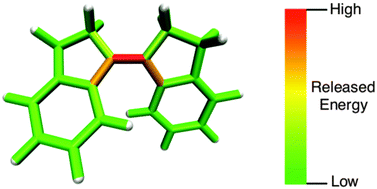Stiff-stilbene photoswitch ruptures bonds not by pulling but by local heating†
Abstract
The photochemical cis → trans-isomerization of stiff-stilbene (1-(1-indanyliden)indan) was previously used to trigger the ring opening of cyclobutene, i.e. the retro [2+2] cycloaddition leading to butadiene, mechanically. However, the forces generated by stiff-stilbene during photoisomerization are limited, so it is unclear in how far the mechanical properties of stiff-stilbene determine the efficiency of the bond rupture. Here we present a computational study in which we investigate the mechanochemical properties of this reaction. We show that the mechanical work transmitted from stiff-stilbene to cyclobutene is much too low to account for the observed facilitation of the ring opening. Hence, local heating resulting from the absorption of a photon by stiff-stilbene and efficient non-radiative decay are the key elements initiating this reaction.


 Please wait while we load your content...
Please wait while we load your content...